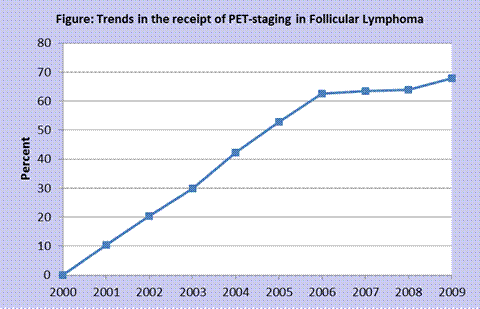Abstract
Background: PET-assisted initial staging (PET-staging) may be useful for the accurate identification of stage I and limited stage II FL patients (pts) as candidates for potentially curative radiotherapy, for guidance of biopsy, and in determining the field of radiation. However, most guidelines recommend its judicious use in FL because its impact on treatment decisions and outcomes remains unclear. We sought to identify the factors associated with the use of PET-staging in FL and its impact on survival.
Methods: We used the linked Surveillance, Epidemiology, and End Results-Medicare database to identify FL patients (pts) ≥ 65 years diagnosed between 2001 and 2009. We defined PET-staging as any whole body PET scan received 3 months prior through 6 months after diagnosis, and before the receipt of any treatment. We used multivariable logistic regression models to evaluate the relationships between pt and treatment setting characteristics, and the use of PET-staging. We examined the effects of PET-staging on overall and lymphoma-related survival (OS and LRS) using standard and propensity score (PS) matched Cox proportional hazards (CPH) regression models adjusted for pt and treatment setting characteristics. We evaluated the effect of unmeasured confounders on survival advantage from PET-staging by performing an instrumental variable (IV) CPH analysis using regional patterns of PET-staging as an instrument associated with PET use but not associated with survival (Wright, J.D. et al. Cancer 2014; Hadley, J. et al. JNCI 2010).
Results: Of the 4,409 eligible pts, 58% were female, 93% were white, 80% lived in metropolitan areas, 23% lived in areas where ≥ 25% of the population had not completed high school, 46% had stage III/IV FL, 18% had grade 3 FL, 6% had B-symptoms, 16% had extra-nodal involvement, 13% had ≥ 2 comorbidities, 13% had poor performance status, and 56% most frequently visited hospitals affiliated with a research network. The increasing use of PET-staging for FL by year is displayed in the figure.
Pts were more likely to undergo PET-staging if they lived in metropolitan areas (ref. less urban/rural pts; odds ratio [OR] 1.30; 95% CI 1.04-1.63); in areas with higher education levels (ref. lower levels; OR 1.25; 95% CI 1.01-1.54); had grade 3 FL (ref. grade 1 or 2 FL; OR 1.56; 95% CI 1.29-1.90); and if they most frequently visited a hospital affiliated with a research network (ref. no affiliation; OR 1.29; 95% CI 1.11-1.49). PET-staging was less commonly associated with age ≥ 81 years (ref. age 66-70; OR 0.55; 95% CI 0.45-0.67), residence in the Midwest region (ref. Southern region; OR 0.49; 95% CI 0.38-0.63), African American race (ref. White race; OR 0.59; 95% CI 0.39-0.89), presence of B-symptoms (OR 0.70; 95% CI 0.53-0.91), and poor performance status (OR 0.63; 95% CI 0.51-0.77).
Results from the CPH regressions are shown in the table. Even after controlling for pt demographics, comorbidities, performance status, disease characteristics, treatment, year of diagnosis, and characteristics of the most frequently visited hospital, PET-staging was associated with improved OS (hazard ratio [HR] 0.77; 95% CI 0.69-0.86) and LRS (HR 0.69; 95% CI 0.57-0.83). This survival advantage persisted after either PS or IV-based adjustments.
Conclusion: PET-staging has been widely used in newly diagnosed FL patients as a baseline investigation before initiation of therapy without well-established evidence of benefits and increased substantially over the study period. Regional, institutional, and socio-demographic variability exists in the use of PET-staging. PET-staging has been more commonly used in higher grade patients, and less commonly used in the oldest patients, patients with poorer performance status, and in patients with B-symptoms, indicating that clinicians may selectively utilize PET-staging for certain subgroups. However, the apparent survival advantage associated with PET-staging may not be entirely due to selection based on observed or unobserved confounders. Further investigation is warranted into the mechanisms of the apparent survival advantage associated with the use of PET-staging in FL.
| . | OS . | LRS . |
|---|---|---|
| Estimation method | HR (95% CI) | HR (95% CI) |
| CPH | 0.77 (0.69 - 0.86) | 0.69 (0.57 - 0.83) |
| Propensity score matched CPH (caliper width 0.005) | 0.82 (0.70 - 0.95) | 0.63 (0.50 - 0.79) |
| Propensity score matched CPH (caliper width 0.01) | 0.81 (0.69 - 0.94) | 0.74 (0.59 - 0.92) |
| IV | 0.44 (0.26 - 0.78) | 0.20 ( 0.09 - 0.46) |
| . | OS . | LRS . |
|---|---|---|
| Estimation method | HR (95% CI) | HR (95% CI) |
| CPH | 0.77 (0.69 - 0.86) | 0.69 (0.57 - 0.83) |
| Propensity score matched CPH (caliper width 0.005) | 0.82 (0.70 - 0.95) | 0.63 (0.50 - 0.79) |
| Propensity score matched CPH (caliper width 0.01) | 0.81 (0.69 - 0.94) | 0.74 (0.59 - 0.92) |
| IV | 0.44 (0.26 - 0.78) | 0.20 ( 0.09 - 0.46) |
No relevant conflicts of interest to declare.
Author notes
Asterisk with author names denotes non-ASH members.


This feature is available to Subscribers Only
Sign In or Create an Account Close Modal